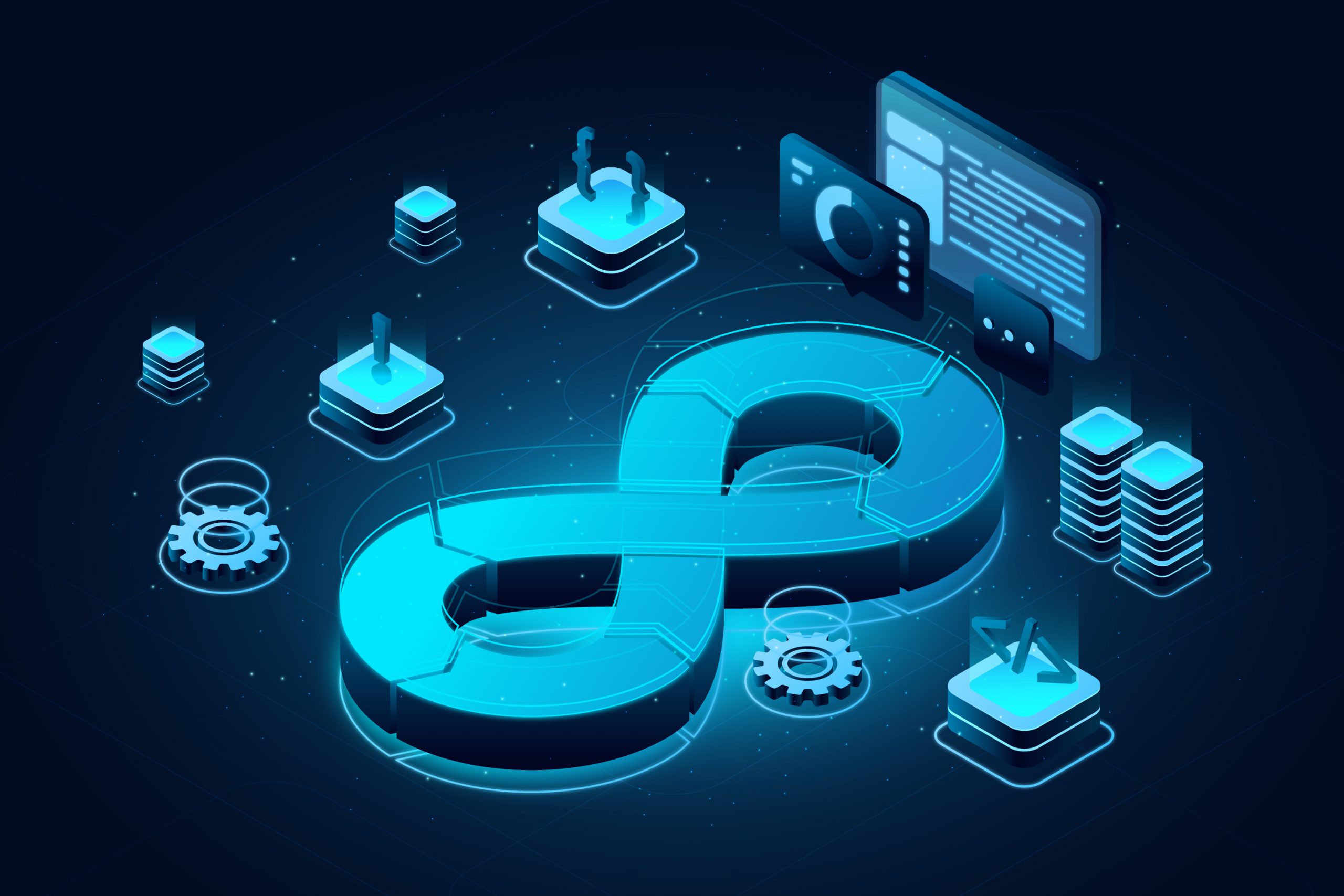Posted on: 17 04 2024.
8 DevSecOps Best Practices for 2024

Imagine constructing a building. With each new level added, security specialists meticulously inspect the structure for weaknesses. This embodies DevSecOps, a method that incorporates security throughout the software development process. It’s not an afterthought; it forms the core of creating applications.
So how do you put DevSecOps into action?
No need to worry, we’ve got your back. Here are eight essential DevSecOps best practices that will revolutionize your development approach into a security stronghold.
1. Prioritize Early Security Measures: Addressing Vulnerabilities Before They Arise (Shift-Left Security)
Traditionally, security assessments occurred late in the development phase, often resulting in setbacks and rework. DevSecOps changes this by emphasizing early security measures. Think of it as constructing a home—you wouldn’t wait until the roof is installed to verify the foundation, would you? Here’s how to shift left:
- Threat Modeling: Conduct workshops early on to identify potential threats hackers might exploit.
- Secure Coding Standards: Establish coding guidelines that prevent common security pitfalls, such as buffer overflows or SQL injection vulnerabilities.
- Static Application Security Testing (SAST): Incorporate SAST tools into your development process. These tools examine your code for security weaknesses in real-time and identify problems before they escalate.
When you “Shift-Left”, you embed security at the heart of your application, which ultimately helps in saving both time and money.
2. Automate Security Testing: Allowing Machines to Take on the Heavy Workload
Manual security testing can be error-prone and tedious. DevSecOps promotes automation at every stage of the process. Here are the main areas to focus on:
- Unit Tests: Important for developers to create unit tests that also include security checks. These serve as small-scale security inspections for each code segment.
- Integration Tests: Automating security tests as part of the integration (CI) flow is crucial. This helps in catching vulnerabilities early, preventing them from spreading to later phases.
- Security Scans: Incorporate vulnerability scanners for code, containers, and infrastructure as code (IaC) into your CI/CD pipeline. These act as automated security guards, constantly scanning for weaknesses.
- Dynamic Application Security Testing (DAST): Automate DAST tools to scan live applications for vulnerabilities that may be overlooked by SAST.
By utilizing automation, security professionals can focus on more strategic tasks, maintain consistent security standards, and offer prompt feedback to developers.

3. Continuous Monitoring: Maintaining Security Awareness
Cybersecurity threats are akin to changing weather: conditions can shift rapidly from day to day. DevSecOps focuses on monitoring applications and infrastructure to detect any suspicious activity immediately. Here are the essential tools for effective monitoring:
- Security Information and Event Management (SIEM): Utilize SIEM tools to gather and analyze logs from applications, infrastructure, and security tools. They function as security investigators, searching for any behavior that could signal an attack.
- Runtime Application Self-Protection (RASP): Integrate tools that oversee applications in real-time to identify and prevent attacks as they happen.
- Vulnerability Scanning: Set up routine vulnerability scans on applications and infrastructure to pinpoint and fix discovered vulnerabilities. Think of it as health checkups for your systems.
Continuous monitoring provides insights into your security posture, enabling teams to promptly respond when threats are detected.
4. Shared Responsibility Model: Understanding Who’s on Watch
In today’s world, ensuring security requires great collaboration. DevSecOps teams need to understand the “Shared Responsibility Model,” which clarifies how security responsibilities are divided between cloud service providers and their customers:
- Responsibilities of Cloud Providers: Cloud providers are responsible for protecting the infrastructure (IaaS) and platform services (PaaS), which can be seen as the foundation of the cloud framework they provide.
- Customer Responsibilities: Clients are responsible for securing their applications and data hosted on the cloud platform (SaaS). It’s their duty to construct fortresses and secure what’s valuable inside.
Understanding this model is crucial for DevSecOps teams to implement appropriate security measures for their applications and data in a cloud environment.
5. Immutable Infrastructure: Building on a Rock-Solid Foundation
Traditional infrastructure management involves patching and configuring servers, a process prone to human error. DevSecOps promotes the concept of immutable infrastructure:
- Infrastructure as Code (IaC): Define infrastructure configurations in code (e.g., using tools like Terraform or Ansible). This allows you to treat your infrastructure like software—repeatable and manageable.
- Version Control: Store IaC configurations in version control systems for tracking changes and rollbacks. Think of it like a blueprint for your infrastructure with a history of all the revisions.
- Provisioning: Set up your infrastructure using code to maintain safe configurations every time. Picture being able to deploy your infrastructure knowing that it’s constructed based on the blueprint each time.
When infrastructure changes are required, a new version of the IaC code is deployed, effectively creating a new instance with the desired configuration. This eliminates the risk of human error and ensures consistent security settings across deployments.

6. Security as Code: Making Security Policies Actionable with SaC
Just as infrastructure can be defined as code, so can security policies. Security as Code (SaC) offers several advantages:
- Policy as Code: Security policies are defined in code (e.g., using tools like Open Policy Agent or Styra). This makes them clear, concise, and easily enforceable.
- Version Control: SaC configurations are stored in version control systems, enabling tracking and rollbacks. This allows you to see how your security policies have evolved over time and revert to previous versions if necessary.
- Enforcement: SaC policies can be automatically enforced during the deployment process, ensuring compliance with security best practices.
SaC fosters consistency, repeatability, and collaboration in security practices across different environments.
7. Continuous Education and Training: Sharpening the Skills for the Security Fight
Security threats and technologies are constantly evolving. DevSecOps emphasizes continuous education and training for all teams involved:
- Security Awareness Training: Educate all developers, operations staff, and other stakeholders on DevSecOps best practices. This equips everyone to identify and mitigate potential security risks.
- DevSecOps Training: Offer specific training on DevSecOps best practices, including tools, processes, and methodologies. This empowers teams to collaborate effectively within the DevSecOps environment.
- Staying Current: Encourage participation in conferences, workshops, and online resources to keep everyone up-to-date on the latest security threats and DevSecOps best practices.
By continuously learning and adapting, DevSecOps teams can stay ahead of the curve and build applications that are resilient against evolving threats.
8. Feedback and Improvement: Building a Culture of Security Excellence
DevSecOps represents a journey of enhancement. Here’s a guide on nurturing a culture centered around learning and feedback:
- Incorporate Security Feedback Loops: Ensure that security issues detected during testing are effectively communicated to developers for resolution. This establishes a loop of feedback that enhances the security stance.
- Conduct Post Incident Analysis: Following security breaches, perform analyses to pinpoint underlying causes and implement preventive measures. Embrace your mistakes as learning opportunities to fortify your applications.
- Utilize Metrics and Evaluation: Keep track of security metrics, such as the number of vulnerabilities discovered and resolved. This enables you to gauge progress and pinpoint areas for enhancement.
By embracing feedback, deriving lessons from incidents, and monitoring progress, DevSecOps teams can consistently refine their methodologies.

Building a DevSecOps Fortress
DevSecOps isn’t simply a collection of tools; it embodies a mindset. By adopting these top-notch methods, you can revolutionize your development approach into a security stronghold, crafting applications that are safe, dependable, and roll out swiftly. Keep in mind, DevSecOps is a process, not a final goal. By growing, adjusting, and working together, you can construct a DevSecOps shield that safeguards your applications and data from even the most advanced threats.



